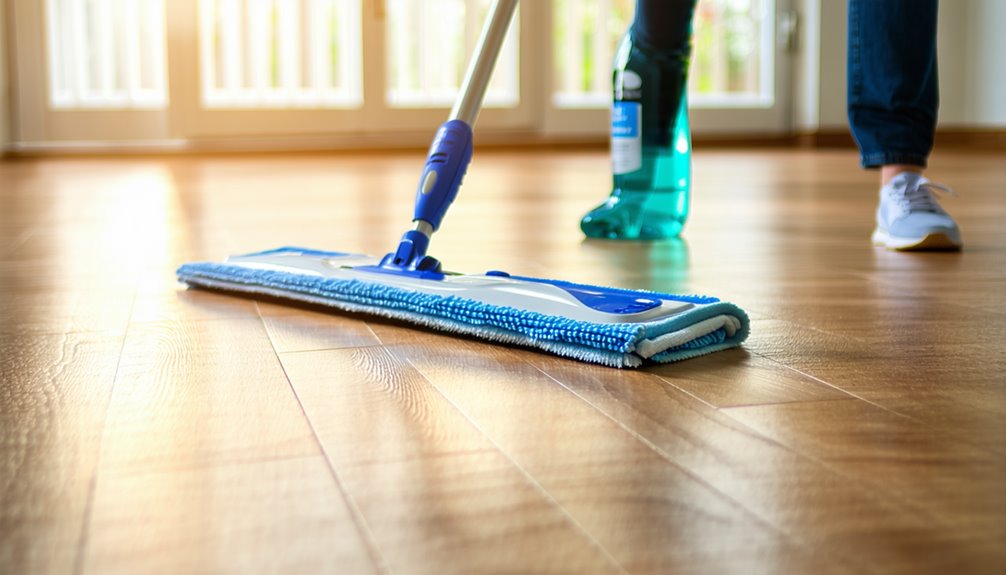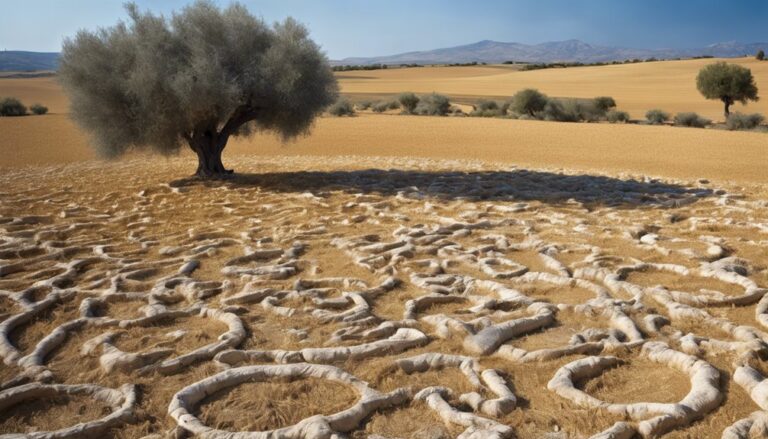Cleaning your vinyl plank flooring is simple and effective. Start by sweeping or vacuuming to remove dust and debris. Next, mix a pH-neutral cleaner with warm water in a bucket. Using a microfiber mop, lightly apply the solution, making sure not to saturate the planks. For tough stains, gently scrub with a soft-bristle brush. After cleaning, rinse your mop in clean water and dry the floor with a clean mop or towel. For stubborn stains, consider baking soda or vinegar solutions. Regular maintenance will keep your floors looking great, and there's more to discover about keeping them pristine.
Understanding Vinyl Plank Flooring

Vinyl plank flooring is a popular choice for homeowners seeking durability and aesthetic appeal. With various vinyl plank types available—such as luxury vinyl planks and rigid core options—you can find a style that fits your taste while enjoying practical advantages. One of the greatest flooring benefits is its resistance to water and stains, making it ideal for high-traffic areas or moisture-prone spaces like kitchens and bathrooms. Additionally, vinyl planks are softer underfoot compared to traditional hardwood, adding comfort to your living space. They're also easy to install, allowing you the freedom to transform your home without the hassle of extensive renovations. Understanding these features helps you make an informed decision that suits your lifestyle and enhances your home's beauty.
Essential Cleaning Supplies
To effectively clean vinyl plank flooring, you'll need a few essential supplies that guarantee the job is done right. Start with basic cleaning tools like a soft-bristle broom or a vacuum cleaner designed for hard floors to remove dust and debris. A microfiber mop is ideal for applying cleaning solutions without scratching the surface. For cleaning solutions, choose a pH-neutral cleaner specifically formulated for vinyl plank flooring; avoid harsh chemicals that can damage the finish. You might also want a bucket for mixing solutions and a clean cloth for spot cleaning. Having these supplies on hand assures you're ready to maintain your flooring's beauty and longevity, giving you the freedom to enjoy your space without worry.
Step-by-Step Cleaning Process

Cleaning your vinyl plank flooring can be a simple process if you follow these steps carefully. First, sweep or vacuum the floor to remove dust and debris. Next, prepare a cleaning solution using a few drops of dish soap mixed with warm water. Use a microfiber mop to apply the solution, ensuring you don't saturate the planks. For tough spots, gently scrub with a soft-bristle brush. Rinse the mop in clean water and go over the area again to remove soap residue. Finally, dry the floor with a clean, dry mop or towel to prevent water spots. By using these effective cleaning techniques, you'll maintain the beauty and longevity of your vinyl flooring, making floor maintenance a breeze.
Tips for Stubborn Stains
Even with regular maintenance, stubborn stains can sometimes mar the appearance of your flooring. Don't worry; you can tackle these tricky issues with the right approach. Here are some effective stain removal tips using cleaning solutions:
- Baking Soda Paste: Mix baking soda with water to form a paste. Apply it to the stain, let it sit for 10-15 minutes, then gently scrub with a soft cloth.
- White Vinegar Solution: Combine equal parts white vinegar and water. Use a soft cloth to apply it to the stain, allowing it to sit for a few minutes before wiping clean.
- Commercial Cleaners: Opt for a vinyl-safe commercial cleaner. Follow the instructions closely to guarantee effective and safe stain removal.
With these methods, your flooring will look fresh and clean again!
Preventative Maintenance Practices

While maintaining the beauty of your vinyl plank flooring, implementing preventative maintenance practices can save you time and effort in the long run. Start by establishing a maintenance schedule that includes regular sweeping or vacuuming to remove dirt and debris. This prevents scratches and keeps your floors looking fresh. Use felt pads under furniture to avoid scuffing and consider placing mats at entryways to trap dirt. If spills occur, wipe them up immediately to prevent staining. Additionally, avoid using harsh chemicals or abrasive tools that could damage the finish. Regularly inspect your flooring for signs of wear and tear, allowing you to take preventive measures before issues escalate. By following these practices, you guarantee your floors remain stunning and durable.
Frequently Asked Questions
Can I Use a Steam Mop on Vinyl Plank Flooring?
Using a steam mop on vinyl plank flooring can feel like dancing on a tightrope—there are benefits and drawbacks. The steam mop's ability to sanitize and eliminate dirt is appealing, but it can also warp or damage your flooring if the heat and moisture are too intense. You'll want to check your manufacturer's guidelines before deciding, ensuring you maintain your floor's beauty while enjoying the freedom of a cleaner home.
How Often Should I Deep Clean Vinyl Plank Flooring?
You should deep clean your vinyl plank flooring every one to three months, depending on foot traffic. While daily maintenance like sweeping or vacuuming is essential, using the right cleaning products for deeper cleans is vital. Make sure to avoid harsh chemicals that could damage the finish. Regularly deep cleaning helps maintain the floor's appearance, ensuring it stays looking fresh and vibrant, giving you the freedom to enjoy your space worry-free.
Is It Safe to Use Vinegar on Vinyl Plank Flooring?
Yes, it's generally safe to use a vinegar solution on vinyl plank flooring, but it's important to dilute it properly. Mix one part vinegar with three parts water for a gentle cleaning solution. This can help remove grime without damaging your floor. Just remember to follow up with a dry mop or cloth to prevent moisture buildup. For more effective cleaning tips, consider alternating with a designated vinyl floor cleaner for best results.
Can Pets Scratch Vinyl Plank Flooring?
You know what they say: "An ounce of prevention is worth a pound of cure." When it comes to pets and vinyl plank flooring, it's true that pet nail impact can cause scratches, especially if your furry friend is particularly energetic. However, vinyl plank flooring is designed for durability, and many options resist scratches well. To maintain that durability, regular grooming of your pet's nails can help keep your flooring looking its best.
What Should I Do if My Vinyl Flooring Starts to Warp?
If your vinyl flooring starts to warp, it's essential to act quickly. First, identify any water damage that might've caused the issue. Remove any standing water and allow the area to dry completely. For flooring repairs, you might need to replace warped planks. Verify the subfloor is dry and level before reinstalling. Consider using dehumidifiers to prevent future moisture issues. Regular maintenance can help you maintain the beauty and longevity of your flooring.




